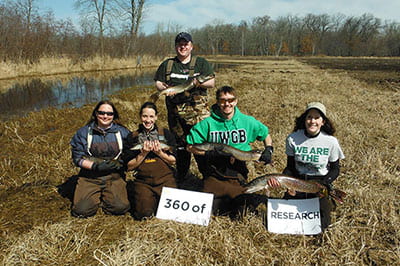Researchers to the rescue: Science students help save fish
 Something is very fishy around here. And by that we don’t mean suspicious. With hundreds of miles of shoreline and its tributaries, UW-Green Bay students have an outdoor lab nearly anywhere they look. Assistant Professor Patrick Forsythe (Natural and Applied Sciences) and his students are taking advantage.
Something is very fishy around here. And by that we don’t mean suspicious. With hundreds of miles of shoreline and its tributaries, UW-Green Bay students have an outdoor lab nearly anywhere they look. Assistant Professor Patrick Forsythe (Natural and Applied Sciences) and his students are taking advantage.
On Tuesday, April 22, students from Forsythe’s Ichthyology class joined the Department of Natural Resources, Brown County Land Conservation and the Shedd Aquarium to rescue 41 northern pike trapped in spring spawning grounds near Suamico. The pike travel upstream into wetlands and ditches, but cannot make the return trip when water levels subside.
UWGB students were able to help in every aspect of the rescue, Forsythe said. The fish are temporarily stunned, netted, measured, tagged and returned to the bay. Fox 11 featured the rescue.
On a separate day, Forsythe and a few students worked with Environmental Science and Policy graduate student Rachel Vandam, whose research goal is to determine contributions of restored wetlands to native Great Lakes fish, with northern pike as a surrogate for the wetlands’ success (prompting the 360° of research image).
“Various organizations have been involved for many years in creating or restoring degraded wetland areas on the west shore of Green Bay,” Vandam says. “The goal of these wetlands is to support spawning activity for northern pike, and ultimately improve the population of the fish in Green Bay. However, many of these spawning wetlands were built without knowing what the northern pike prefer in them, and the contributing groups are interested in finding out how successful the wetlands are.”
Vandam’s project is looking at three sites that represent a range of variation in the restorations, to determine important features to incorporate into future wetlands, as well as features that perhaps the pike don’t prefer. She monitors the adults moving into and out of each wetland.
“I measure their length, take a fin clip to do genetic analysis (both between adults, and also with the young fish that will swim out of the wetland once they hatch), and I place a floy tag in each fish to monitor how long it stays in the wetland, when it leaves, and if it comes back.”
Her works also involves surveying the types (species) and amount of vegetation at each site, since the pike will only spawn in vegetation such as grasses or sedges. She then monitors where the adults are spawning within the wetlands, and compares it to the vegetation and the water temperature. After spawning and egg hatch, she uses box traps to determine how many fish leave the wetland, when they leave, and measures how big they are when they leave.
She will also be doing some genetic analysis, to determine if all the adults or only a few have contributed to the young-of-year in the wetlands.
“Ultimately, I am hoping that the information I get on where the adults spawn and the young-of-year congregate, will help me to determine important features of the wetlands, in combination with the vegetation and temperature information. Then I will be able to inform the groups constructing the wetlands on the best features to include.”
(Click thumbnails to enter slideshow view.)

























Photos by Eric Miller, Marketing and University Communication




